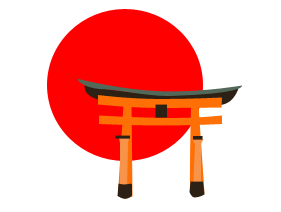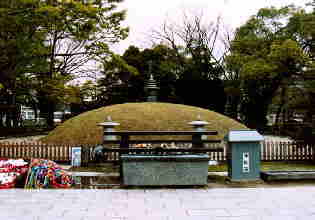
After the bombing of Hiroshima, innumerable bodies were gathered from the rivers in this area and many other places in the city, and cremated here day after day. It is said people could not tell if the bodies were men or women as they were heavily damaged.
Only this Mound holds the ashes among the monuments in and around the Peace Memorial Park. Today the ashes of approximately seventy thousands unidentified bodies are kept in a vault inside this ancient-style burial mound. Some identified ashes are waiting to be claimed by their families and relatives.
Every summer the names of those victims are released to the public. Even after 50 years families from all over Japan are still coming to Hiroshima every year to claim ashes. Every year on August 6, prayers are offered for these victims in a memorial ceremony by many different religions.
(Photo:Akemi Satoda)
Monument in Memory of the Korean Victims of the Atomic Bomb
The Monument in Memory of the Korean Victims of the Atomic Bomb was erected in l970 by the The Korean Residents Union in Japan, Hiroshima Local Main Office.
The tower stands on a large turtle-shaped base. At the top of the tower there is a crown engraved with dragons. In that crown there is the register of names of over 2,500 people who were killed at the time the bomb exploded. In Korea a legend says that the dead pass on to heaven on the back of a turtle or a dragon. The entire monument was built in the Republic of Korea using Korean stones, and was later transported here.
The inscription on the monument reads in full “Monument in Memory of the Korean Victims of the Atomic Bomb: Prince Lee-Woo and 20,000 others”. About 20,000 Korean people are estimated to have suffered because of the bombing. Prince Lee-Woo, mentioned in the inscription, was a nephew of the last Korean Crown Prince.
When he was eleven years old, he was brought to Japan by the Japanese government. He was a staff officer in education. He was near the Aioi Bridge when the atomic bomb exploded. Although he was brought to the first aid station in Ninoshima Island, he died the next day. It is said that this monument was built at this site because he was found in this area.
The construction of the South-and-North Korean unified monument was searched, but it was very difficult to find a mutually-satisfactory content for the epigraph. Since the former Mayor Takashi Hiraoka reached a compromise for the people concerned, the movement of the monument into the Park was decided in December of 1998. The unified one will be erected in the Park in the near future, though the present one is going to be moved as a tentative measure.
(Photo:Akemi Satoda)
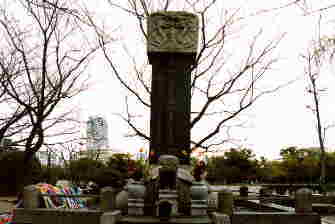
Paulownia
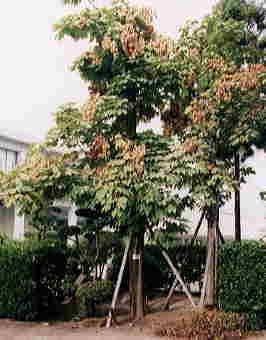
These two trees were exposed to the atomic bomb at a distance of 1.5 km from the hypocenter and were transplanted here in 1973. They survived the bombing, although half of the trunk facing the hypocenter was burnt to a crisp.
After the bombing, it was reported that no plants would grow in Hiroshima for some 70 years. But new buds grew and encouraged depressed survivors to carry on their lives. These trees are a testimony to nature’s ability to overcome, and an inspiration to the people of Hiroshima. Some of the survivors have been growing second generation trees from the seeds of these exposed trees. Wishing to spread the anti-war and anti-nuclear idea all over the country, they are distributing these seeds to visiting students who plant and raise them all over Japan.
(Photo : Katsumi Sasaki)
The story of Suzuko Numata
Peace Bell
The Peace Bell is surrounded by lotus plants which are considered sacred in Buddhism. They are in full bloom around the memorial day, August 6. The lotus flower is an important symbol in the Buddhist tradition. Because it rises above the mud to bloom, the lotus symbolizes the human capacity to rise above the world’s impurities and attain enlightenment.
If you look closely at the Bell, you will see a world map with no national boundaries. It symbolizes one world. The concrete belfry in the shape of a dome represents the universe. The roof is supported by four pillars which symbolize the four inevitable sufferings of this world – life, old age, disease and death. There is a mirror on the front surface of the Bell to allow us to look at our inner selves.
Visitors, wishing a peaceful world, can freely toll the bell, which sounds all over the Peace Memorial Park.
(Photo : Katsumi Sasaki)
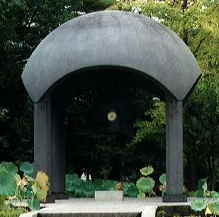
Atomic Bomb Dome
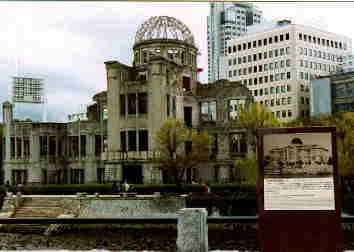
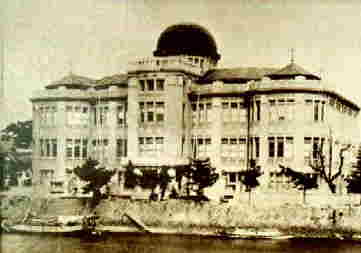
This is the ruins of the former Hiroshima Prefectural Industrial Promotion Hall, which was designated as a Cultural World Heritage site of UNESCO in 1996. During the Sino- and Russo-Japanese Wars, Hiroshima developed as a military and industrial city. The Hall became familiar to the citizens as a symbol of the economic strength of Hiroshima.
At 8:15 a.m. on August 6, 1945, an atomic bomb was dropped on human beings for the first time in history. The A-bomb exploded in the air about 580 meters above the Shima Hospital. The ground zero was at the Shima Hospital. Because the Dome was located almost right under the burst point, only the framework of the building survived with the inside destroyed.
The temperature of the hypocenter reached 3,000-4,000 degrees Celsius, which is three times as high as that of iron melting, 1,550 degrees. The blast of the bomb ran through the city with a speed of 440m per second at the first stage, killing people and destroying everything within a radius of 2 km.
B-29 bomber Enola Gay dropped the bomb from an altitude of about 10,000m above the Aioi Bridge. According to the recent TV report, as the A-bomb exploded 580m above the ground, neutron rays were emitted in all directions. (released by NHK TV ‘A-bomb Dropping – 10 seconds impact ‘ on Aug. 6, 1998 )
After the explosion, a big fireball was made, and it emitted the intense heat rays, the blast wind, and the deadly radiation. Those covered all over the city, which turned to the scorched plain. It is said that about 30 people inside the Hall at that time were killed in an instant.
The Hall was originally built by a Czech architect, Jan Letzel, and was very popular among people before the atomic bomb explosion. After the bombing people started to call it the A-bomb Dome. It kept decaying as the years went by, and work to preserve it became necessary. But there were some arguments both for and against the preservation.
Actually, a diary of a girl led them to the movement of preserving the Dome. The girl, Hiroko Kajiyama, was exposed to radiation at the age of two like Sadako Sasaki, who kept on folding a thousand paper cranes in her disease, leukemia. She died 15 years later at the age of 17. The cause of her death was also leukemia. Knowing that she wrote in her diary the Dome encouraged her to survive, her family, friends and other people supported the movement of the preservation of A-bomb Dome.
In July of 1996, the City Assembly passed a resolution to preserve it. Contributions came from numerous peace-loving people here in Japan and all over the world. The preservation works were carried out twice until now.
Today the Dome stands not only as a witness to the inhuman cruelty of wars and nuclear weapons, but also to warn people never to repeat the evil.
(Photo:Akemi Satoda)
